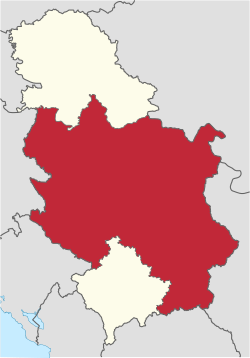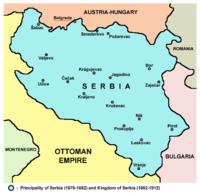Central Serbia
Central Serbia | |
|---|---|
 Map of Central Serbia withinSerbia | |
| Largest city | Belgrade |
| Area | |
• Total | 55,968 km2(21,609 sq mi) |
| Population | |
• 2022 census | 4,906,773 |
• Density | 87.6/km2(226.9/sq mi) |
| Time zone | UTC+1(CET) |
• Summer (DST) | UTC+2(CEST) |
Central Serbia(Serbian:централна Србија,romanized:centralna Srbija), also referred to asSerbia proper(Serbian:ужа Србија,romanized:uža Srbija),[a]is theregionofSerbialying outside the autonomous province ofVojvodinato the north and the disputed Kosovo region to the south. Central Serbia is a term of convenience, not anadministrative divisionof Serbia as such, and does not have any form of separate administration.
Broadly speaking, Central Serbia is the historical core ofmodern Serbia,which emerged from theSerbian Revolution(1804–17) and subsequent wars against theOttoman Empire.In the following century, Serbia gradually expanded south, acquiring South Serbia, Kosovo,SandžakandVardar Macedonia,and in 1918 – following the unification and annexation ofMontenegroand unification ofAustro-Hungarianareas left of theDanubeandSava(Vojvodina) – it merged with other South Slavic territories into theKingdom of Yugoslavia.The current borders of Central Serbia were defined after World War II, when Serbia became arepublicwithin theSocialist Federal Republic of Yugoslavia,with Kosovo and Vojvodina as its autonomous provinces.
Geography
[edit]Central Serbia takes up, roughly, the territory of Serbia between the natural borders consisting of theDanubeandSava(in the north), theDrina(in the west), and the "unnatural" border to the southwest withMontenegro,south withKosovoandNorth Macedonia,and to the east withBulgaria,with a small strip of the Danube with Romania in the northeast. The Danube and Sava divides central Serbia from the Serbian province ofVojvodina,while the Drina divides Serbia from Bosnia and Herzegovina. TheGreat Morava,a major river, goes through central Serbia. Extensions of three major mountain chains are located within Serbia proper:Dinaric Alpsin the west and south, and theCarpathiansandBalkan Mountainsin the east.
Some notable geographical regions located in central Serbia are:Šumadija,Mačva,theTimok Valley(including theNegotin Valley),Pomoravlje,Podunavlje,Posavina,Podrinje,ZlatiborandRaška.
History
[edit]

In theRoman period,"Moesia"was the name for a region that included Serbia proper.Viminacium(present-dayKostolac) was the capital of the province ofMoesia Superior.Slavs (Sclaveni) overwhelmed the Balkans in the 6th and 7th centuries. The Serbs, a Slavic tribe, were known to have held the area of what is today southwest Serbia in the Early Middle Ages, while theRoyal Frankish Annalsmention theBraničevciandTimočani,in the eastern parts, in the 9th century.Raška,situated in the southwest, was the core of the medieval Serbian state;Stari Rashas been identified as a capital of theGrand Principality of Serbia.Serbia eventually expanded its borders to the east. The area of most of Serbia proper, as well as areas in eastern Bosnia and Herzegovina, northern Montenegro, Kosovo, and northern Macedonia were called "the Serbian lands", included in the styles of medieval Serbian rulers. KingStefan Dragutinof Syrmia (r. 1282–1316) had two capitals,DebrcandBelgrade.After thefall of the Serbian Empire,the "Moravian Serbia"underLazar(r. 1373–89) andStefan Lazarević(r. 1389–1402) corresponded roughly to Serbia proper.Kruševacwas the capital of Moravian Serbia, until the Ottoman conquests in the 15th century, and the establishment of theSerbian Despotate,with the capital in Belgrade. After the Ottoman conquest of the Serbian Despotate, theSanjak of Smederevowas established, initially seated inSmederevo,and eventually, in Belgrade afterits fall in 1521(hence called the "Pashaluk of Belgrade" ).
Between 1718 and 1739, the Sanjak of Smederevo was occupied by theHabsburg monarchy,which administered the area as theKingdom of Serbia.TheSerbian Militiaoperated throughout Serbia proper during the1737–39 war.The war ended in Ottoman victory, and returning of the sanjak. The northern half of Serbia proper was briefly underHabsburg occupationduring the1787–91 war,then returned. With theFirst Serbian Uprising(1804–13), the sanjak became ade factoSerbian state, known in historiography as "Revolutionary Serbia".It was retaken by the Ottomans in 1813, however, theSecond Serbian Uprising(1815–17) saw Serbia recognized as an autonomous principality within the Ottoman Empire. In 1878, Serbia became a fully independent state, also enlarging its territory to the south-east. The 1878 borders correspond to present-day Central Serbia save for small parts in the south-west.
In theBalkan Wars(1912–13), Serbia further expanded its borders to the south, taking control of much of present-dayKosovoandNorth Macedonia.Further territorial gains were made in the north (today'sVojvodina) and south-west (Sandžakregion) in 1918, afterWorld War I.Serbia became part of the newKingdom of Serbs, Croats and Sloveneson December 1, 1918. Serbia proper did not have a separate political status within the Kingdom; in 1929, when new provinces of the Kingdom were formed, Serbia proper was divided between fivebanovine,one of which (Morava Banovina) was established in the east with its capital inNiš.
Between 1941 and 1944, most of the territory was part of the area governed by theMilitary Administration in SerbiaunderGerman Wehrmachtoccupation with a Serbian puppet government. The southwestern region ofSandžakwas occupied byItalyand annexed to the neighbouringItalian governorate of Montenegro;southern Kosovo was annexed toAlbaniawhile southeastern parts annexed byBulgaria.
The Axis occupation ended in 1944 with the liberation of Yugoslavia by theYugoslav Partisans;Serbia was formed as one of the republics of the new socialistYugoslavia.In 1945, Vojvodina and Kosovo became autonomous provinces within Serbia, thus the part of Serbia that was outside these two regions became known asuža Srbija( "Serbia proper" ). At the beginning of the 1990s, the termuža Srbijawas replaced with the new termCentralna Srbija( "Central Serbia" ) which was used in all official publications of the Serbian government that referred to the region.
With the formation of newstatistical regions of Serbiain 2009–10, three statistical regions:Belgrade,Šumadija and Western SerbiaandSouthern and Eastern Serbiaform Central Serbia.[1]
Administrative divisions
[edit]
Districts of Serbia,according to theStatistical regions of Serbia.
| District | Area (km2) | Population (2011) |
Seat |
|---|---|---|---|
| Belgrade | |||
| 3,227 | 1,659,440 | ||
| Belgrade | 3,227 | 1,659,440 | Belgrade |
| Šumadija and Western Serbia | |||
| 26,483 | 2,062,945 | ||
| Mačva | 3,264 | 298,931 | Šabac |
| Kolubara | 2,474 | 174,513 | Valjevo |
| Moravica | 3,016 | 212,603 | Čačak |
| Zlatibor | 6,142 | 286,549 | Užice |
| Šumadija | 2,387 | 293,308 | Kragujevac |
| Pomoravlje | 2,614 | 214,536 | Jagodina |
| Raška | 3,922 | 309,258 | Kraljevo |
| Rasina | 2,664 | 273,247 | Kruševac |
| Southern and Eastern Serbia | |||
| 26,255 | 1,563,916 | ||
| Podunavlje | 1,250 | 199,395 | Smederevo |
| Braničevo | 3,865 | 183,625 | Požarevac |
| Bor | 3,510 | 124,992 | Bor |
| Zaječar | 3,623 | 119,967 | Zaječar |
| Nišava | 2,727 | 376,319 | Niš |
| Pirot | 2,761 | 92,479 | Pirot |
| Toplica | 2,229 | 91,754 | Prokuplje |
| Jablanica | 2,770 | 216,304 | Leskovac |
| Pčinja | 3,520 | 159,081 | Vranje |
| 55,965 | 5,286,301 | ||
Demographics
[edit]Ethnic groups of Central Serbia according to the 2022 census:
- Serbs:4,169,454 (84.97%)
- Bosniaks:153,083 (3.12%)
- Romani:90,998 (1.85%)
- Albanians:59,752 (1.22%)
- Vlachs:20,828 (0.42%)
- ethnic Muslims:10,592 (0.23%)
- Bulgarians:11,795 (0.24)
- Montenegrins:7,814 (0.15%)
- Croats:6,423 (0.13%)
- Yugoslavs:14,705 (0.30%)
- Macedonians (ethnic group)7,746 (0.15%)
In 2022, most of the municipalities of Central Serbia had an ethnic Serb majority, three municipalities (Novi Pazar,Tutin,andSjenica) had a Bosniak majority, two municipalities (BujanovacandPreševo) had an Albanian majority and two municipalities (BosilegradandDimitrovgrad) had a Bulgarian majority.[2]
See also
[edit]Annotations
[edit]- ^Besides the name "Central Serbia", the term "Serbia proper" was also used inEnglishto refer to the region. "Serbia proper" is simply an English translation of the Serbian termUža Srbija(Ужа Србија), which was used as a name of the region during the existence of theSocialist Federal Republic of Yugoslavia;the term was controversial and, due to that, Serbian government publications usedCentralna Srbija(Централна Србија, "Central Serbia" ) instead. The termUža Srbijawas rejected because it implied a distinction between Serbia and its autonomous provinces. According to theLibrary of Congress,"Serbia Proper" denoted "the part of the Republic of Serbia not including the provinces of Vojvodina and Kosovo; the ethnic and political core of the Serbian state."[3]
References
[edit]Notes
[edit]References
[edit]- ^"2011 Census of Population, Households and Dwellings in the Republic of Serbia: Comparative Overview of the Number of Population in 1948, 1953, 1961, 1971, 1981, 1991, 2002 and 2011, Data by settlements"(PDF).Statistical Office of Republic Of Serbia, Belgrade. 2014.ISBN978-86-6161-109-4.Retrieved2014-06-27.
- ^"Попис становништва, домаћинстава и станова 2011. у Републици Србији"(PDF).stat.gov.rs.Republički zavod za statistiku. Archived fromthe original(PDF)on 11 August 2014.Retrieved2 June2015.
- ^The Library of the Congress.Glossary - Yugoslavia.
